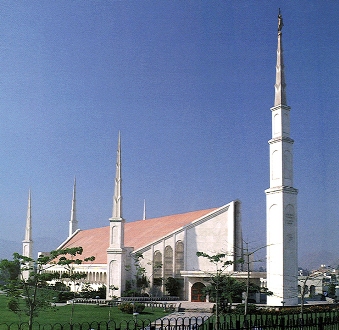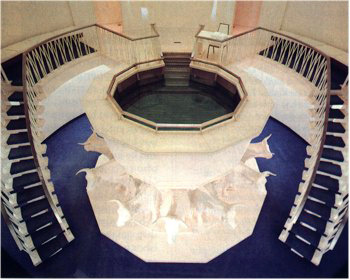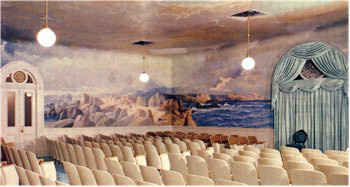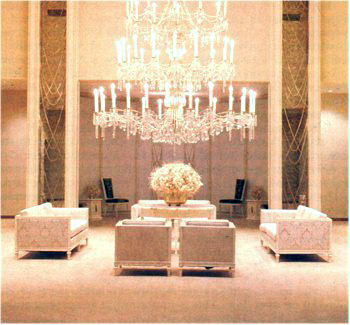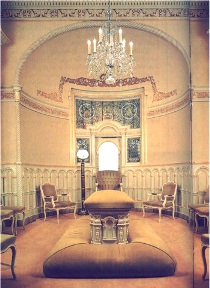Difference between revisions of "Inside Mormon Temples"
| (40 intermediate revisions by 12 users not shown) | |||
| Line 1: | Line 1: | ||
| − | + | [[Category:Beliefs]][[Category: Temples]] | |
| − | + | [[Image:Lima_peru_mormon_temple.jpg|thumb|250px|alt=Lima Peru Mormon Temple|Lima Peru Temple © Intellectual Reserve]] | |
| − | + | [[Mormon temple|Temples]] of [http://comeuntochrist.org The Church of Jesus Christ of Latter-day Saints] now dot the globe, so many people in the world have seen the outside of a Latter-day Saint temple. Temples are designed and dedicated by the power of the [[Priesthood Authority|priesthood]] to be houses of the Lord. They are sanctuaries from the cares and wickedness of the world. The holiness and spirituality of temples can be perceived from far off. Many are situated on hills and lit so that they shine at night. The gardens surrounding Latter-day Saint temples are serene and peaceful. Before temples are dedicated—after which only worthy Latter-day Saint members can enter—tours are normally held so that people can see what temples look like inside. | |
==A Place Set Apart from the World== | ==A Place Set Apart from the World== | ||
| + | The interior of a Latter-day Saint temple is designed with care and built and decorated to the highest standard. The design of temples has always been given by revelation, because a temple is the Lord's house. All of the workers who construct a temple are Latter-day Saints worthy to attend the temple once it is built and dedicated. That is, every construction worker has a [[Temple Recommend|temple recommend]] stating his worthiness. Temples are full of light. They are not built to impress the attendee with overarching awe, as great cathedrals do, but to create an atmosphere of peace and purity. | ||
| − | + | To those who are prepared, the temple is a "holy place" where the Spirit of the Lord can freely dwell. The temple is a place for prayer, thought, reflection, and revelation. | |
| − | |||
| − | |||
| − | |||
| − | To those who are prepared, the temple is a "holy place" where the Spirit of the Lord can freely dwell. | ||
==A Place for Sacred Ordinances== | ==A Place for Sacred Ordinances== | ||
| + | There are special, holy ordinances that can only be performed within temples. Temple [[Ordinances]] are simple, symbolic ceremonies performed as a way to signify covenants made between the Church member and God. | ||
| − | + | Inside the temple there are primarily two ordinances performed for the members of the [http://mormonendowment.com/825/mormon-temples Church of Jesus Christ]. The first of these ordinances is known as the [[temple endowment]], and the second as the sealing ordinance, key to [[celestial marriage]]. The first ordinance is designed for individuals, and the second is designed to create eternal [[Families|families]]. These ordinances are very sacred and holy, so faithful Latter-day Saints don't discuss their details outside of the temple, even with each other. | |
| − | + | ==Ordinances for Others== | |
| + | Not only are temples provided so that ordinances can be done for the living, but ordinances in the temples can also be done for those who are dead. Latter-day Saints believe that earthly ordinances must be performed for those who are no longer capable of performing these ordinances for themselves. There are billions of people who have lived on this earth without ever hearing the name of Christ, or coming to understand the sacrifice He made for them. After death, these people have lived as spirits in the [[Spirit World]], awaiting judgment. As spirits, they have enjoyed the same [[Agency|freedom of choice]] given them as mortals living on earth. Christ and emissaries of Christ preach among the spirits in the spirit world (see [https://www.churchofjesuschrist.org/study/scriptures/dc-testament/dc/138?lang=eng Doctrine and Covenants, secion 138]). Should any of those spirits choose to accept Christ's gospel, they must have ordinances performed. All of the ordinances offered in the temple for living members of the Church of Jesus Christ are also performed by proxy for those who have passed on. Temple marriage, sealings, and endowments are performed with someone symbolically standing in for the person who is deceased. Baptisms are also performed by proxy for these people who have passed on. The dead are free to accept or ignore these ordinances. | ||
| − | : | + | ==A Glimpse Inside the Temple== |
| + | [[Image:Baptistry_wash.jpg|thumb|250px|right|alt=Washington Mormon Temple Baptistry|Washington Temple Baptistry © Intellectual Reserve]]Temple interiors are designed for the purposes described above. At the entrance of each temple, there is a waiting room for patrons and their families. Then there is a recommend desk, where patrons show their [[Temple Recommend|temple recommend]]s to temple workers at the desk. The recommend shows their worthiness to enter a sacred house of God. Another waiting room for patrons is usually located behind the recommend desk. There are offices for the [[Temple President]], a room for temple clothing rental, a "family file" room for genealogical record help, and other rooms for building function and maintenance. Everyone who works in the temple dresses completely in white. Temple patrons arrive in clothing suitable for a Church service and then change into white clothing for the duration of their temple stay. | ||
| − | The | + | The '''baptistry''' is where baptisms for the dead are performed. Baptistries are designed just as they were anciently—mounted on the backs of twelve oxen. Separate dressing rooms are provided for the baptistry. |
| − | + | [[Image:Creation_sl.jpg|left|thumb|250px|alt=Salt Lake Mormon Temple Creation Room|Salt Lake Temple Creation Room © Intellectual Reserve]]The [[Plan of Salvation]] message is a very important part of the endowment ritual. The plan that God has for His children is imparted. Because the Plan of Salvation is a plan of progression, in earlier Latter-day Saint temples patrons progressed from room to room as the plan was taught. Now in most newer temples, patrons remain in a single '''endowment room'''. The number of endowment rooms varies according to the size of the temple, and the size of the temple varies according to the population of Saints in the area where the temple is located. The first [[Pioneer Temples|temples]] built by the [http://mormonendowment.com/find-a-meetinghouse Church of Jesus Christ] had murals painted on the walls of the endowment rooms portraying the creation and other scenes relating to the Book of Genesis. Now, endowment rooms are generally plainer, though decorated in tranquil colors and motifs. | |
| − | + | After completing the endowment, patrons in all temples move to the '''celestial room''' of the temple, where they may spend some time meditating or praying. The celestial room of a temple is always exquisitely beautiful, the decor always fine and reverent. No ordinances are performed in the celestial room of the temple. | |
| − | = | + | [[Image:Celestial_provo.jpg|thumb|250px|alt=Provo Mormon Temple Celestial Room|Provo Temple Celestial Room © Intellectual Reserve]]Sealings, whether it be to perform a [[Celestial marriage|celestial marriage]] ceremony or to seal children to their parents, are ordinances pertaining to the eternal nature of the family unit. They are performed in sealing rooms. A '''sealing room''' has an altar in the center of the room. The groom kneels on one side, and the bride kneels on the other. Chairs are arranged around the periphery of the room for the guests in attendance. Decorative mirrors are mounted on opposing walls, so that they repeatedly reflect each other into infinity, a symbol of the eternal covenant. Guests who attend a temple marriage ceremony don't change into white clothing. They are ushered into a sealing waiting room, and then into the sealing room, after they enter the temple. The [[LDS Weddings|bride and groom]] wear white, and the bride may wear a wedding gown, if it is white and modest. A husband and wife being sealed to their children wear white temple clothes, and the children dress in white. |
| + | [[Image:Sealing_sl.jpg|right|thumb|250px|alt=Salt Lake Mormon Temple Sealing Room|Salt Lake Temple Sealing Room © Intellectual Reserve]] | ||
| − | + | <videoflash>sTEsfQTtPKM&feature=youtu.be&rel=0</videoflash> | |
| − | + | ===External Links=== | |
| + | *[https://www.churchofjesuschrist.org/study/ensign/2010/10/the-holy-temple?lang=eng The Purpose of Temples from Boyd K. Packer] | ||
| + | *[https://www.churchofjesuschrist.org/study/ensign/2010/10/why-these-temples?lang=eng#:~:text=%E2%80%9CThese%20are%20they%20which%20came,7%3A13%E2%80%9315). "Why These Temples" by Gordon B. Hinckley] | ||
| + | *[https://www.churchofjesuschrist.org/pages/a-history-of-temples-talmage?lang=eng "A History of Temples" by James E. Talmage] | ||
| + | *[http://www.lightplanet.com/mormons/temples/celestial_room.html A Virtual Tour of Celestial Rooms] | ||
| + | *[http://www.lightplanet.com/mormons/temples/endowment_room.html A Virtual Tour of Temple Endowment Rooms] | ||
| + | *[http://www.lightplanet.com/mormons/temples/baptism_font.html A Virtual Tour of Temple Baptistries] | ||
| + | *[http://www.lightplanet.com/mormons/temples/sealing_room.html A Virtual Tour of Temple Sealing Rooms] | ||
| + | *[http://www.lightplanet.com/mormons/temples/index.html Mormon Temples] | ||
| + | *[https://www.churchofjesuschrist.org/church/temples/find-a-temple?lang=eng Find a Temple] | ||
| + | *[https://www.churchofjesuschrist.org/temples/photo-gallery?lang=eng Photographs of LDS Temples] | ||
| − | + | [[es:Interior de los Templos Mormones]] | |
| + | [[fr:Rôle du temple]] | ||
| + | [[it:Dentro il tempio]] | ||
| + | [[ru:Внутри мормонских храмов]] | ||
| + | [[de:Im_Tempel]] | ||
| + | [[tl:Sa loob ng Templo]] | ||
| + | [[pt:Dentro dos Templos Mormons]] | ||
Revision as of 00:12, 1 January 2021
Temples of The Church of Jesus Christ of Latter-day Saints now dot the globe, so many people in the world have seen the outside of a Latter-day Saint temple. Temples are designed and dedicated by the power of the priesthood to be houses of the Lord. They are sanctuaries from the cares and wickedness of the world. The holiness and spirituality of temples can be perceived from far off. Many are situated on hills and lit so that they shine at night. The gardens surrounding Latter-day Saint temples are serene and peaceful. Before temples are dedicated—after which only worthy Latter-day Saint members can enter—tours are normally held so that people can see what temples look like inside.
Contents
A Place Set Apart from the World
The interior of a Latter-day Saint temple is designed with care and built and decorated to the highest standard. The design of temples has always been given by revelation, because a temple is the Lord's house. All of the workers who construct a temple are Latter-day Saints worthy to attend the temple once it is built and dedicated. That is, every construction worker has a temple recommend stating his worthiness. Temples are full of light. They are not built to impress the attendee with overarching awe, as great cathedrals do, but to create an atmosphere of peace and purity.
To those who are prepared, the temple is a "holy place" where the Spirit of the Lord can freely dwell. The temple is a place for prayer, thought, reflection, and revelation.
A Place for Sacred Ordinances
There are special, holy ordinances that can only be performed within temples. Temple Ordinances are simple, symbolic ceremonies performed as a way to signify covenants made between the Church member and God.
Inside the temple there are primarily two ordinances performed for the members of the Church of Jesus Christ. The first of these ordinances is known as the temple endowment, and the second as the sealing ordinance, key to celestial marriage. The first ordinance is designed for individuals, and the second is designed to create eternal families. These ordinances are very sacred and holy, so faithful Latter-day Saints don't discuss their details outside of the temple, even with each other.
Ordinances for Others
Not only are temples provided so that ordinances can be done for the living, but ordinances in the temples can also be done for those who are dead. Latter-day Saints believe that earthly ordinances must be performed for those who are no longer capable of performing these ordinances for themselves. There are billions of people who have lived on this earth without ever hearing the name of Christ, or coming to understand the sacrifice He made for them. After death, these people have lived as spirits in the Spirit World, awaiting judgment. As spirits, they have enjoyed the same freedom of choice given them as mortals living on earth. Christ and emissaries of Christ preach among the spirits in the spirit world (see Doctrine and Covenants, secion 138). Should any of those spirits choose to accept Christ's gospel, they must have ordinances performed. All of the ordinances offered in the temple for living members of the Church of Jesus Christ are also performed by proxy for those who have passed on. Temple marriage, sealings, and endowments are performed with someone symbolically standing in for the person who is deceased. Baptisms are also performed by proxy for these people who have passed on. The dead are free to accept or ignore these ordinances.
A Glimpse Inside the Temple
Temple interiors are designed for the purposes described above. At the entrance of each temple, there is a waiting room for patrons and their families. Then there is a recommend desk, where patrons show their temple recommends to temple workers at the desk. The recommend shows their worthiness to enter a sacred house of God. Another waiting room for patrons is usually located behind the recommend desk. There are offices for the Temple President, a room for temple clothing rental, a "family file" room for genealogical record help, and other rooms for building function and maintenance. Everyone who works in the temple dresses completely in white. Temple patrons arrive in clothing suitable for a Church service and then change into white clothing for the duration of their temple stay.The baptistry is where baptisms for the dead are performed. Baptistries are designed just as they were anciently—mounted on the backs of twelve oxen. Separate dressing rooms are provided for the baptistry.
The Plan of Salvation message is a very important part of the endowment ritual. The plan that God has for His children is imparted. Because the Plan of Salvation is a plan of progression, in earlier Latter-day Saint temples patrons progressed from room to room as the plan was taught. Now in most newer temples, patrons remain in a single endowment room. The number of endowment rooms varies according to the size of the temple, and the size of the temple varies according to the population of Saints in the area where the temple is located. The first temples built by the Church of Jesus Christ had murals painted on the walls of the endowment rooms portraying the creation and other scenes relating to the Book of Genesis. Now, endowment rooms are generally plainer, though decorated in tranquil colors and motifs.After completing the endowment, patrons in all temples move to the celestial room of the temple, where they may spend some time meditating or praying. The celestial room of a temple is always exquisitely beautiful, the decor always fine and reverent. No ordinances are performed in the celestial room of the temple.
Sealings, whether it be to perform a celestial marriage ceremony or to seal children to their parents, are ordinances pertaining to the eternal nature of the family unit. They are performed in sealing rooms. A sealing room has an altar in the center of the room. The groom kneels on one side, and the bride kneels on the other. Chairs are arranged around the periphery of the room for the guests in attendance. Decorative mirrors are mounted on opposing walls, so that they repeatedly reflect each other into infinity, a symbol of the eternal covenant. Guests who attend a temple marriage ceremony don't change into white clothing. They are ushered into a sealing waiting room, and then into the sealing room, after they enter the temple. The bride and groom wear white, and the bride may wear a wedding gown, if it is white and modest. A husband and wife being sealed to their children wear white temple clothes, and the children dress in white.External Links
- The Purpose of Temples from Boyd K. Packer
- "Why These Temples" by Gordon B. Hinckley
- "A History of Temples" by James E. Talmage
- A Virtual Tour of Celestial Rooms
- A Virtual Tour of Temple Endowment Rooms
- A Virtual Tour of Temple Baptistries
- A Virtual Tour of Temple Sealing Rooms
- Mormon Temples
- Find a Temple
- Photographs of LDS Temples
